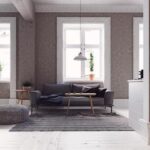Colonial style homes carry with them a rich history and timeless sophistication. From the iconic architecture to the traditional design elements, these homes exude charm and elegance. Understanding the characteristics and significance of colonial style homes is essential in creating an authentic and cohesive decor scheme. In this article, we will explore the history and characteristics of colonial style homes, delving into the significance of colonial style architecture and design.
The colonial style is deeply rooted in American history, reflecting the influence of European settlers on early American architecture. With its symmetrical facade, shuttered windows, and classic columns, colonial homes exude a timeless appeal that continues to captivate homeowners today. By understanding the historical context and architectural features of these homes, one can effectively embrace the traditional charm of colonial design in their own living space.
From selecting the right color palette to incorporating colonial-inspired decor and accessories, this article will serve as a comprehensive guide on how to decorate a colonial style home with authenticity and finesse. Whether it’s utilizing traditional patterns and textiles or preserving architectural authenticity, each aspect of decorating a colonial style home will be thoroughly explored.
Get ready to immerse yourself in the world of colonial aesthetics as we uncover the secrets to achieving a truly captivating interior design for your colonial home.
Selecting the Right Color Palette
Choosing the right color palette is key when it comes to decorating a colonial style home. The traditional color schemes for colonial homes often include a mix of neutral tones, earthy shades, and rich, deep colors that reflect the historical significance of this architectural style. When selecting colors for your colonial home, it’s important to consider the era in which the home was built and the regional variations of colonial design.
To create an authentic colonial look, consider using colors such as deep reds, forest greens, navy blues, and warm yellows. These hues were commonly used during the colonial period and can help capture the timeless elegance of this design style. Additionally, incorporating neutral tones like off-white, creamy beige, and soft browns can provide a complementary backdrop for these bolder colors.
When considering how to decorate a colonial-style home with the right color palette, it’s essential to take into account not only the interior walls but also the exterior of the home. Colonial architecture typically features symmetrical designs with prominent front doors and windows. Choosing colors that accentuate these features while maintaining historical accuracy is crucial for achieving an authentic colonial aesthetic.
In addition to paint colors, textiles and upholstery fabrics should also be considered when deciding on a color palette for a colonial-style home. Incorporating traditional patterns such as plaid or floral prints in coordinating shades can further enhance the overall look and feel of each room.
| Colonial Color Palette | Recommended Colors |
|---|---|
| Main Exterior Color | Deep Red or Navy Blue |
| Trim and Accent Color | Creamy Beige or Forest Green |
| Interior Walls | Warm Yellows or Soft Browns |
Embracing Traditional Colonial Furniture
When it comes to decorating a colonial style home, selecting the right furniture is essential in capturing the timeless elegance and charm of this traditional architectural style. Embracing traditional colonial furniture not only adds authenticity to the home’s interior but also creates a cohesive and harmonious look that complements the overall design aesthetic.
Iconic Furniture Pieces for Colonial Homes
To create an authentic colonial look, consider incorporating iconic furniture pieces such as Windsor chairs, ladder-back chairs, wingback armchairs, chippendale sofas, and Queen Anne-style tables. These classic furniture pieces are synonymous with colonial design and often feature solid wood construction, graceful curves, and rich upholstery. Additionally, large wooden dining tables with intricate carvings and detailed craftsmanship are well-suited for formal dining rooms in colonial homes.
Finding Authentic Colonial Furniture
When looking for traditional colonial furniture, consider visiting antique shops, estate sales, and auctions where you can find genuine pieces from the 17th and 18th centuries. If authentic colonial furniture is out of budget or scarce in your area, high-quality replicas and reproductions are widely available from reputable furniture manufacturers. Look for pieces crafted from solid woods such as cherry, mahogany, or walnut to emulate the stately appeal of original colonial furnishings.
Tips for Arranging Colonial Furniture
Arranging traditional colonial furniture in your home involves creating inviting seating areas, highlighting architectural focal points like fireplaces or grand entryways with elegant furnishings, and maintaining a sense of symmetry throughout the space. For instance, place classic camel-back sofas or settees adorned with delicate floral upholstery alongside polished dark wood coffee tables to evoke a sense of timeless refinement within your living area.
By embracing traditional colonial furniture within your home’s interior design scheme, you will be able to capture the essence of historical elegance and sophistication that defines this beloved architectural style. Whether through iconic pieces or quality reproductions, selecting furnishings that harmonize with the space’s historical context is fundamental in creating an inviting atmosphere that celebrates the rich heritage of colonial design.
Incorporating Colonial Patterns and Textiles
When it comes to decorating a colonial style home, incorporating traditional patterns and textiles is essential for achieving an authentic look and feel. Colonial homes often feature timeless and classic patterns that harken back to the historical roots of this architectural style. By carefully selecting the right patterns and textiles, you can create a cohesive and inviting space that pays homage to the colonial era.
Exploring Traditional Patterns and Textiles
To decorate a colonial style home, consider incorporating traditional patterns such as toile, chintz, and damask. These patterns were popular during the colonial period and adding them to your home can instantly evoke a sense of history and elegance. Additionally, incorporating floral prints, stripes, and plaids in upholstery, curtains, and accent pieces can also enhance the colonial aesthetic.
Using Textiles for Cohesive Look
Textiles play a crucial role in tying together the various elements of a colonial style home. Consider using rich fabrics such as velvet, silk, or cotton in warm tones like deep reds, blues, greens, and golds. These textiles can be used for upholstery, curtains, throw pillows, and bedding to create a cohesive look throughout the home. Additionally, consider layering different textures such as quilts, needlepoint pillows, or braided rugs to add depth and visual interest to the space.
Where to Find Colonial Patterns and Textiles
When looking for traditional colonial patterns and textiles for your home decor, consider visiting antique shops or specialty stores that specialize in historical reproductions. Additionally, many fabric retailers offer reproduction fabrics inspired by colonial designs that are suitable for furniture reupholstery or creating custom window treatments.
Online marketplaces can also provide a wide array of options for sourcing authentic or reproduction colonial textiles for your home decorating needs. By choosing the right patterns and textiles that complement your colonial style home’s color palette and furniture pieces will help create an inviting space with historical charm.
Adding Colonial-Inspired Decor and Accessories
When decorating a colonial style home, it’s crucial to pay attention to the decor and accessories that will complement the traditional aesthetic. Incorporating colonial-inspired decor such as brass accents, candles, and wall art can elevate the overall design of the home. One way to achieve this is by sourcing historical and cultural elements that reflect the time period when colonial homes were first built.
An essential aspect of decorating a colonial style home is to incorporate historically accurate decor and accessories. Look for brass or copper candlestick holders, as well as antique-style mirrors with intricately carved frames. These pieces will add an authentic colonial touch to your home while also serving as conversation starters for guests.
In addition to historical elements, incorporating different types of textiles into your home can enhance the colonial aesthetic. Consider using fabrics like damask, toile, or chintz for curtains, upholstery, and pillows. These traditional patterns have been used in colonial homes for centuries and can help create a cohesive look throughout your space.
To complete the overall look, consider displaying artwork that reflects the time period of colonial architecture. Paintings or prints depicting pastoral scenes or historical events can add depth to your interior design. When choosing wall art, look for pieces with ornate frames or vintage reproductions that align with the colonial era.
| Colonial-Inspired Decor | Colonial Aesthetic |
|---|---|
| Brass accents | Elevates traditional design |
| Historical artwork | Reflects time period of architecture |
| Textiles such as damask | Create a cohesive look |
Achieving Architectural Authenticity
When decorating a colonial style home, it is essential to pay attention to architectural authenticity in order to fully capture the charm and character of these historic homes. Achieving architectural authenticity involves preserving and highlighting the distinctive features that are synonymous with colonial architecture. Here are some tips on how to achieve this authentic look:
- Preserve original features: If your colonial home has original architectural features such as woodwork, moldings, or trim, make sure to preserve them. These details add a sense of history and craftsmanship to the home.
- Enhance with colonial-style woodwork: To enhance the interior of your colonial home, consider adding or restoring colonial-style woodwork such as wainscoting, paneling, and ceiling beams. This can help elevate the traditional aesthetic of the space.
- Highlight historical elements: Pay attention to any historical elements in your home and find ways to showcase them. For example, if your home has a fireplace with a traditional mantelpiece, use it as a focal point in the room and decorate it with colonial-inspired decor.
Using these tips will help you achieve architectural authenticity when decorating your colonial style home. By preserving original features, enhancing with colonial-style woodwork, and highlighting historical elements, you can create a timeless and authentic look that honors the rich history of colonial architecture.
Lighting and Fixtures in a Colonial Home
Lighting and fixtures play a crucial role in enhancing the historical charm and traditional aesthetic of a colonial style home. By selecting suitable lighting options and historically accurate fixtures, homeowners can elevate the overall design and create an authentic colonial ambiance. Here are some tips for choosing the right lighting and fixtures for your colonial home:
- Opt for Chandeliers: Chandeliers are a hallmark of colonial interior design. Choose a chandelier with classic brass or iron details to add a touch of elegance to your living space. Look for designs that feature candle-style bulbs to emulate the historic look of early lighting.
- Sconces and Wall Lamps: Incorporating sconces and wall lamps can help to effectively illuminate hallways, stairwells, and entryways in a colonial style home. Select designs with simple, yet traditional elements such as antique finishes, glass shades, or wrought iron details.
- Table Lamps: When choosing table lamps for your colonial home, consider styles that reflect the sophistication of the era. Opt for lamps with ceramic or brass bases paired with fabric shades that complement the color palette of your space.
By incorporating these historically accurate lighting options into your colonial home, you can achieve an authentic atmosphere while also illuminating your interiors effectively. Additionally, consider consulting with lighting specialists who are knowledgeable about historical designs to ensure that the fixtures you select align with the architectural authenticity of your home. Embracing these traditional lighting elements will undoubtedly enhance the colonial charm and beauty of your living spaces.
With attention to detail and careful consideration of historical accuracy, homeowners can truly capture the essence of colonial design in their lighting choices. Whether it’s chandeliers in grand dining rooms or wall sconces in cozy reading nooks, each fixture contributes to the overall ambiance of a well-decorated colonial style home.
Outdoor Spaces
In conclusion, decorating a colonial style home involves more than just selecting the right color palette or furniture. It requires attention to the historical and architectural elements that define this classic American style. By embracing traditional colonial patterns, textiles, decor, and accessories, homeowners can create a cohesive look that reflects the timeless elegance of colonial design.
Achieving architectural authenticity is essential in decorating a colonial style home. Preserving and highlighting the architectural features such as woodwork, moldings, and trim adds an extra layer of charm to the interior. Incorporating historically accurate lighting fixtures also plays a crucial role in maintaining the overall design integrity of a colonial home.
Furthermore, outdoor spaces should not be overlooked when decorating a colonial style home. Landscaping and patio design should reflect the same timeless aesthetic as the interior. Incorporating colonial design elements into backyards, patios, and gardens completes the cohesive look of a colonial style home. Understanding how to decorate a colonial style home means paying attention to every detail – from inside to outside – to truly capture the essence of this classic American architectural style.
Frequently Asked Questions
How Can I Make My House Look Colonial?
Making your house look colonial involves incorporating classic architectural elements such as columns, symmetrically placed windows, and a front door with a decorative pediment. Using neutral or earthy tones for the exterior paint can also give it that colonial aesthetic.
How to Furnish a Colonial-Style Home?
Furnishing a colonial-style home means embracing traditional, elegant pieces of furniture like wingback chairs, Chippendale or Queen Anne style tables, and upholstered sofas. Incorporating antiques, brass hardware, and rich wood finishes will enhance the authentic colonial feel.
What Are the Best Colors for a Colonial House?
The best colors for a colonial house are often muted and earthy tones such as white, cream, beige, gray, and warm browns for the exterior. These colors reflect the timeless elegance of colonial architecture and create a welcoming, classic look for your home’s facade.
For interior walls, consider using historic-inspired colors like deep reds, hunter greens, navy blues, or mustard yellows to complement the colonial style.

I’m thrilled to be your companion on this exciting journey through the world of home decor and design. With a passion for turning houses into homes and a keen eye for the finer details, I’m here to help you transform your living spaces into beautiful, functional, and meaningful havens.





